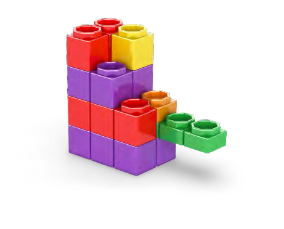My cart


Problem: Younger children struggle with complex building systems.
Solution: QBOIDZ - a new type of building block with a one-step snap action.
Benefits: Our products are designed to foster growth and development in children from ages 1.5 to 6. Our snap-fit system allows for complex structures to be built, promoting persistence and perseverance. As children build, they enhance fine motor skills, hand-eye coordination, and dexterity. With no limits to creativity and imagination, children can construct unique designs, improving spatial awareness and perception for better direction comprehension. Our products also encourage problem-solving skills to overcome building challenges and foster social skills and teamwork through collaborative building. As children accomplish and succeed in building, their confidence and self-esteem are boosted.
Why does it work? Playing with blocks is not only fun but also helps to stimulate important cognitive skills in children. According to Piaget, a renowned cognitive psychologist, children are like little scientists who actively engage in the learning process through experiments and observations. This is where QBOIDZ building blocks come in handy. These blocks are specifically designed to promote active learning and cognitive development in infants and toddlers during the Sensorimotor stage of cognitive development, which lasts from birth to age two. During this stage, children acquire knowledge through sensory experiences and manipulating objects, such as sucking, grasping, looking, and listening. QBOIDZ building blocks provide an interactive and exciting way for children to enhance their spatial perception and three-dimensional thinking skills. By manipulating the blocks, children can also build upon their existing knowledge and adapt their ideas to accommodate new information, aligning with Piaget's theory of how children continually learn and grow by interacting with the world around them.
How is different from other building systems? QBOIDZ allows for side-building, creating new neuron connections, and enhancing brain development. What differentiates “Qboidz” blocks from any other brick systems, is the incorporation of the original ENGINO snap-fit geometries on the cube’s body! By selectively embedding the ENGINO bi-directional receptors and the mushroom-shaped plugs on the block’s sides, the possibility to connect rods to blocks became a reality. Our QBOIDZ system is perhaps the only constructional toy that grows with the child, respecting his or her needs at every stage of their development, from the age of 3 to 6.
ENGINO Research team has identified Levels of Dimensional Thinking to encourage engineering creativity and innovative thinking in children.

One-dimensional Thinking
Stacking blocks vertically:
Stack the patented cubic blocks (named Qboidz) vertically as with traditional brick systems, teaching basic construction skills, and developing hand-eye coordination.

Two-dimensional Thinking
Connecting blocks to the side:
Children enhance their building skills by connecting blocks sideways, exploring 3D space, and improving their spatial perception and dexterity.

Three-dimensional thinking
Combining blocks with beams:
This level requires a higher force of assembly, encouraging them to build more detailed constructions and develop problem-solving skills and creativity.

Fourth-dimensional Thinking
Compatible with Engino system:
Children are introduced to the standard ENGINO system, suitable for ages 6+, where the Qboidz parts can seamlessly transition, allowing them to work on a finer grid system and create more complex models.

Fifth-dimensional Thinking
Coding with robotic parts:
Children can learn coding skills through interdisciplinary STEM challenges by building robotized constructions with Qboidz system that is fully compatible with programmable controllers and sensors, adding programmable robotics to the mix, and building upon the first three generations of construction toys.

